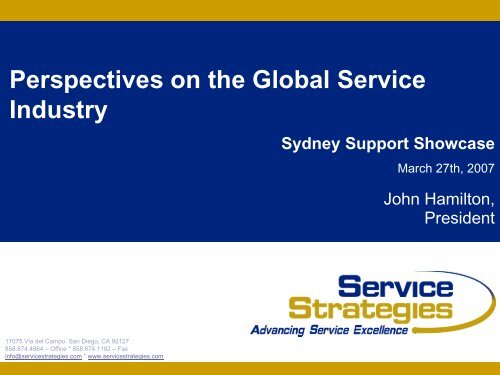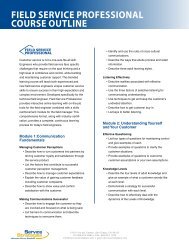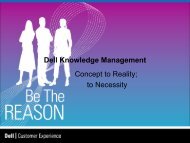Enterprise Support - Service Strategies
Enterprise Support - Service Strategies
Enterprise Support - Service Strategies
Create successful ePaper yourself
Turn your PDF publications into a flip-book with our unique Google optimized e-Paper software.
Perspectives on the Global <strong>Service</strong><br />
Industry<br />
Sydney <strong>Support</strong> Showcase<br />
March 27th, 2007<br />
John Hamilton,<br />
President<br />
17075 Via del Campo San Diego, CA 92127<br />
858.674.4864 – Office * 858.674.1192 – Fax<br />
info@servicestrategies.com * www.servicestrategies.com
Who is <strong>Service</strong> <strong>Strategies</strong> Corporation<br />
We are a Global <strong>Service</strong> Improvement Company<br />
• Provide consulting, training, and standards programs<br />
specifically for technology service organizations<br />
• Business Improvement <strong>Service</strong> Capability &<br />
Performance Standards for:<br />
• <strong>Support</strong> Center<br />
• Field <strong>Service</strong>s<br />
• Professional <strong>Service</strong>s<br />
• Develop industry benchmarks and facilitate best practice<br />
sharing
Agenda<br />
• Global Challenges for <strong>Service</strong> Delivery<br />
• Trends in Offshore Outsourcing<br />
• Mergers & Acquisitions<br />
• <strong>Enterprise</strong> <strong>Support</strong><br />
• Self <strong>Service</strong> - e<strong>Service</strong>s<br />
• Industry Standard – <strong>Service</strong> Improvement
Today’s Global <strong>Support</strong> Challenges<br />
Increase <strong>Support</strong><br />
Revenues<br />
More Value-Added <strong>Service</strong>s<br />
Reduce <strong>Support</strong> Costs<br />
Utilization<br />
Consolidation<br />
<strong>Support</strong> Automation<br />
Expanded Partner<br />
Relationships<br />
Sales and <strong>Support</strong> Channels<br />
external from organization<br />
Increased<br />
Complexity<br />
Minutes=Millions<br />
<strong>Support</strong>ing Customer’s<br />
Business – Not just<br />
your Product<br />
Compliance<br />
>16,000 regulations<br />
worldwide
Trends in Offshore Outsourcing<br />
What are the tradeoffs
<strong>Support</strong> Infrastructure for the Flattened<br />
Global Economy
Offshore Outsourcing<br />
• Offshoring and Outsourcing have become key business<br />
strategies<br />
• Driven primarily by the need to reduce cost<br />
• Major concerns about:<br />
• <strong>Service</strong> quality – customer satisfaction<br />
• Job losses (America and EMEA)<br />
• Technical and customer service skills
Today… Outsourced Locations
Offshore Outsourcing<br />
• India has gained the leading outsourced market share for English<br />
language support outside of America and EMEA<br />
• Provide high tech, call center support and help desk<br />
• Agent wages 30-40% less than U.S. and Europe<br />
• Skilled workforce of over 25 million graduates – 2 million new<br />
graduates/year<br />
• Issues<br />
• Voice and data bandwidth issue impacting growth<br />
• Communication cultural issues with “English accent”<br />
• High staff turnover
Asian Outsourcing<br />
China is rapidly becoming the new location for Asian<br />
language support - Chinese, Korean, Japanese<br />
• Call Center (non tech) growing rapidly<br />
• Technical <strong>Support</strong>, IT and BPO evolving<br />
• Software engineering high growth<br />
• Similar to India, China produces over 2m graduates<br />
annually with advanced degrees in Computer Science,<br />
Engineering, Business, etc…
Status of Offshore Outsourcing<br />
Successes<br />
• Consumer support – high volume, low complexity<br />
• e<strong>Support</strong> – email & web service – non voice interactions<br />
Failures<br />
• <strong>Enterprise</strong> level support – mission critical/complex<br />
• Dell, NCR, NetApp, and a number of other companies withdrew<br />
from India due to customer dissatisfaction issues
OffShore, Outsourcing Conclusions<br />
• Offshoring or Outsourcing support should not be<br />
primarily a cost reduction measure IT WILL FAIL<br />
• Need to have a global support strategy that includes how<br />
Off Shoring or Outsourcing fits within your service<br />
delivery model<br />
• Plan for a minimum of 5 years<br />
• Will require significant investment in infrastructure, resources<br />
and management – Outsourcing could be an option
Mergers & Acquisitions<br />
<strong>Service</strong> organizational impacts
Mergers and Acquisitions – Trend continues<br />
Recent M&A activity in IT sector:<br />
• Oracle, Symantec, CA, IBM, and many more…<br />
Big fish swallowing the not so little fish<br />
• Disruption of service<br />
• Clash of cultures<br />
• Business systems<br />
• <strong>Service</strong> delivery processes<br />
• <strong>Support</strong> personal<br />
• Customer fear
Organizational Change – ongoing trend<br />
<strong>Service</strong> organization reporting structure<br />
• Chief <strong>Service</strong> Officer – CSO, Board level reporting<br />
• Engineering/R&D<br />
• Sales<br />
• COO<br />
Re-organizations typically happen on a two year cycle<br />
Customers don’t care and still expect quality service
M&A – Lessons for the future<br />
Case studies from:<br />
• Oracle and Peoplesoft<br />
• Symantec and Veritas
<strong>Enterprise</strong> <strong>Support</strong><br />
Premium <strong>Support</strong> Programs
Why <strong>Enterprise</strong> <strong>Support</strong><br />
• Customers demand it!<br />
• C-level executives want strategic value, business<br />
continuity, and no excuses from their IT operations or<br />
vendors<br />
• Customers want “one throat to choke”<br />
• Improve customer satisfaction and loyalty<br />
• Protect and increase support revenue from largest<br />
customers
Market Background<br />
• Vendors are Struggling<br />
• Customer’s expectations growing<br />
• <strong>Enterprise</strong> <strong>Service</strong>s becoming<br />
table stakes<br />
• Most vendor services<br />
organizations are reactive at their<br />
core<br />
• “Let sleeping dogs lie”<br />
• Concentrates on solving cases,<br />
not avoiding them
Driving <strong>Support</strong> Tenets<br />
• Present a single image of service to the customer<br />
• Have clear ownership (accountability and authority)<br />
• Provide consistent quality of service<br />
• Provide clear value to the customer and corporation<br />
• Be scaleable to support large enterprises<br />
• Be measurable (SLA level)<br />
• Be leverage-able through partners
<strong>Enterprise</strong> <strong>Support</strong> Model<br />
Relationship / Partnership / Account Management<br />
S<br />
Y<br />
S<br />
T<br />
E<br />
M<br />
S<br />
Dedicated Team that knows the customers business, configuration,<br />
procedures, risk tolerance, technical environment – etc.<br />
Preventive<br />
<strong>Support</strong><br />
•Architecture<br />
•Configuration<br />
•Best Practices<br />
•Go Live <strong>Support</strong><br />
•Multi Vendor<br />
Design<br />
•Quality RAS<br />
Pro-Active<br />
<strong>Support</strong><br />
•Problem Alerts<br />
•Patch and Release<br />
Planning<br />
•Knowledge Base<br />
•Auto <strong>Support</strong><br />
•Best Practices<br />
•TAM / SPOC<br />
The Solution<br />
•Availability<br />
•24x724x7<br />
Reactive<br />
<strong>Support</strong><br />
•Follow Follow the Sun<br />
•Fast Fast Answers<br />
•Fast Fast Escalation<br />
•Experts<br />
•Patches<br />
•Multi-Vendor<br />
<strong>Support</strong><br />
Lower<br />
TCO<br />
•EOS Extended<br />
Lifecycle<br />
<strong>Support</strong><br />
•Enhancements<br />
•Flexible <strong>Service</strong><br />
Plans<br />
•Managed<br />
<strong>Service</strong>s<br />
•Easy Upgrades<br />
and Installs<br />
This is a Cross-Organizational, Corporate-Wide Effort<br />
P<br />
R<br />
O<br />
C<br />
E<br />
S<br />
S
Common <strong>Enterprise</strong> Themes<br />
• Mission-critical<br />
• Reliability, Availability, <strong>Service</strong>ability<br />
• Fast Resolution when problems occur<br />
• Global Availability<br />
• Relationship<br />
• Pro-Active and Pre-Emptive<br />
• Stop problems before they happen<br />
• Same problem never occurs twice<br />
• Address pre-production and post-production environments
“720 Degree View”<br />
SOWs, Arch Docs,<br />
Other Cust Docs<br />
Contracts &<br />
Amendments<br />
Survey<br />
Results<br />
Account<br />
Team<br />
Open HiPri Cases<br />
<strong>Service</strong> Request<br />
History<br />
Certified Engineers<br />
At Account<br />
TEA Account<br />
Details<br />
DSOs<br />
PS Engagement<br />
History<br />
Maintenance<br />
Renewal Status<br />
Customer<br />
Background<br />
Product Download<br />
History<br />
Now<br />
Company<br />
view<br />
SDC Entitlements<br />
Authorized<br />
Technical Contacts<br />
Reference<br />
History<br />
720 Degree Snapshot<br />
Portal<br />
(Customer Dossier)<br />
Customer<br />
Touch Summary<br />
<strong>Support</strong> Plan<br />
Entitlement Details<br />
R&D<br />
Escalations<br />
Partner involvement<br />
with Account<br />
Internal <strong>Support</strong><br />
Community Competency<br />
Joint PR &<br />
Media Coverage<br />
Special Contract<br />
Terms & Conds<br />
Feature<br />
Requests<br />
External<br />
Research<br />
CRS Report<br />
Customer in<br />
The News<br />
Technical Env<br />
Profiles<br />
Activities<br />
Account<br />
Summary Info<br />
Total Spend<br />
Lic/Maint/Svcs/Trng<br />
Products Owned &<br />
License Restrictions<br />
Invoice<br />
History<br />
Opportunities<br />
License/Svcs<br />
Training Taken<br />
Case Response<br />
Charts<br />
Event Participation<br />
History<br />
Contacts<br />
Customer Lifecycle<br />
Info<br />
Production Events
<strong>Service</strong>s & <strong>Support</strong> Marketing<br />
<strong>Service</strong>s &<br />
support marketing<br />
synchronized with<br />
industry and<br />
product marketing<br />
Whole Product<br />
Solution<br />
Product &<br />
Application<br />
<strong>Support</strong><br />
Technical<br />
Account<br />
Management<br />
Training Classes<br />
On-site<br />
Education<br />
Virtual Labs<br />
E-Learning<br />
Consulting <strong>Service</strong>s<br />
Systems<br />
Enhancement<br />
Implementation<br />
Global<br />
Learning<br />
<strong>Service</strong>s<br />
Professional<br />
<strong>Service</strong>s<br />
Customer<br />
<strong>Service</strong> &<br />
<strong>Support</strong><br />
Integrated<br />
marketing of<br />
“enterprise”<br />
services and<br />
support
Long-term Plan<br />
Unified<br />
<strong>Service</strong>s & <strong>Support</strong> Marketing<br />
Virtual Organization<br />
(Playbook)<br />
Consistent Processes<br />
Customer-Centric Behavior<br />
Response Center<br />
“Best Practices”<br />
Certification<br />
Field Technical<br />
Consultants<br />
Professional<br />
<strong>Service</strong>s
Summary<br />
• <strong>Enterprise</strong> <strong>Support</strong> is all about transitioning customer<br />
experience from “vendor” to “strategic partner”<br />
• Providing C-level executives with confidence in your<br />
solution as a mission-critical enterprise-capable platform<br />
• Working to maintain support revenue and profitability,<br />
while improving customer loyalty<br />
• Expanded support offerings will make your solution more<br />
competitive in the enterprise space
Self <strong>Service</strong>s<br />
e<strong>Service</strong>s
<strong>Support</strong> and <strong>Service</strong> Evolution<br />
We are here<br />
Source: Aberdeen Group,
Superior Self-service is Now a Crucial<br />
Customer service is one of the few differentiators that a<br />
company possesses. Well-executed superior self-service is<br />
now a crucial strategic component of the overall customercentric<br />
business strategy.<br />
To derive maximum value from self-service, companies<br />
must optimize the value of their customer interactions and<br />
not focus solely on self-service as a cost-saving<br />
mechanism.
Web Self-<strong>Service</strong> Interactions Are Increasing
Self-<strong>Service</strong> is a Key Part of Customer<br />
Management<br />
An estimated 60 percent of interactions between customers and an organization are<br />
cross channel and inter-related.<br />
Customer Lifecycle<br />
Generate Interest<br />
Mass<br />
Marketing<br />
Communications Medium<br />
E-Mail Web Phone Meet<br />
Educate Buyer<br />
Establish trust<br />
Evaluate Product/<strong>Service</strong><br />
Negotiations<br />
Make transaction<br />
<strong>Service</strong> and <strong>Support</strong><br />
Cross Sell<br />
Self-<strong>Service</strong><br />
and Assisted<br />
Add Incremental<br />
Insight<br />
Customer Intimacy
Knowledge Foundation Powers <strong>Support</strong> and<br />
Customer Experience<br />
Unified Interaction Experience<br />
Unified <strong>Support</strong> Desktop<br />
• IVR/Speech<br />
• Email Resolution<br />
• Dynamic FAQ’s<br />
Customer Self<br />
<strong>Service</strong> Applications<br />
Assisted <strong>Service</strong><br />
Applications<br />
• Case Management<br />
• Co-browse/Chat<br />
• Natural Language<br />
Search<br />
• Forums<br />
• Personalized Portals<br />
• Scripting<br />
• Next Best Action<br />
• Recommended<br />
Solutions<br />
Customer Inquiries, Problems, Orders, Feedback<br />
Knowledge Foundation<br />
Analytics and Workflow
Phases of Self <strong>Service</strong><br />
1.<br />
One-way<br />
• Informational<br />
• Flat content such as<br />
FAQ’s, policies, product<br />
information<br />
2.<br />
Business Value Impact<br />
Two-way<br />
way<br />
• Reactive Interactions<br />
• Informational and<br />
transactional data<br />
3.<br />
Pro-active<br />
• Pushed and timely<br />
service<br />
• Cross Channel<br />
4.<br />
Dynamic<br />
• In-context informational,<br />
transactional and proactive<br />
self-service<br />
Profitable Self <strong>Service</strong><br />
Un-Profitable Self <strong>Service</strong>
e<strong>Service</strong> Initiative<br />
• e<strong>Service</strong> standards content<br />
• Definition of e<strong>Service</strong> practices<br />
• Expected performance levels<br />
• Method for measuring Success / Deflection<br />
• Opportunities for delivering the standards<br />
• Incorporate portions into <strong>Support</strong> Center content<br />
• Enable standalone certification of e<strong>Service</strong>s<br />
• Offer as an e<strong>Service</strong> framework without certification
High Level e<strong>Service</strong> Criteria<br />
Seven e<strong>Service</strong> Criteria Sections<br />
• Usability and Design<br />
• Self Help <strong>Service</strong>s<br />
• Interactive <strong>Service</strong>s<br />
• Tools and Technologies<br />
• Planning & Processes<br />
• Security / Privacy<br />
• Measures of Success<br />
Over 50 business elements measured and scored
Criteria >>> Elements >>> Attributes Updated 3/3/06<br />
Usability and Design Self Help <strong>Service</strong>s Interactive <strong>Service</strong>s<br />
User Entitlement Functions Online Training <strong>Service</strong>s Notification / Alert <strong>Service</strong>s<br />
Moved to Security / Privacy Section course registration Opt in /out<br />
course objectives and curriculum<br />
Delivery strategy<br />
Content Localization notifications Frequency<br />
Localization strategy delivery methods personalization<br />
Implementation methods users tracking / management execution process<br />
Scope / depth of localization certification delivery methods<br />
Maintenance service level incentives (cert) measurement<br />
Cultural issues course schedules compliance issues<br />
Compliance issues pricing entitlement<br />
priority<br />
Personalization Features<br />
Search Capabilities<br />
Personalized content Filtering Case Management <strong>Service</strong>s<br />
Role based content methodologies SCP Description<br />
Profile management<br />
content sources / formats<br />
Personalized layouts content optimization Live <strong>Support</strong> <strong>Service</strong>s (chat etc.)<br />
Custom views relevancy SCP Description<br />
Personalized reporting / history<br />
transparency<br />
Dynamic / adaptive personalization synonyms User Forums<br />
methods of access<br />
SCP Description<br />
Accessibility of <strong>Service</strong>s<br />
Integration<br />
Uptime performance Assisted Diagnostics<br />
Redundancy search optimization SCP Description<br />
Site performance / optimization presentation of results Remote <strong>Support</strong><br />
Platform support learning capabilities WebEx Etc...<br />
Device <strong>Support</strong> / awareness<br />
Desktop Sharing<br />
Conforming to accessibility standards<br />
Tools<br />
Plug-in requirements Self Diagnostics Online Meetings / Seminars<br />
Pop-ups… Contract Management / Admin tools Recording of Webinars<br />
Configuration tools<br />
Technical Topics / Upgrades Etc.<br />
Ease of Navigation<br />
Proactive Notification of Sessions<br />
Single Login Content Sessions on Use of e<strong>Service</strong> Offerings<br />
Intuitive / Simplicity Administrative Content Tour or Web site / KB etc
Recommendations<br />
• Use the service channel as a differentiator to create memorable<br />
experiences.<br />
• Integrate self-service with assisted service support channels.<br />
• Infuse proactive contextual guidance and knowledge<br />
throughout the customer interaction for improved<br />
effectiveness.<br />
• Segment and proactively anticipate customer needs with<br />
preemptive recommendations for both marketing and service<br />
interactions<br />
• Use analytics to continually optimize the service experience
<strong>Service</strong> Capability & Performance<br />
Standards<br />
Program overview
What’s the Program All About<br />
• Industry driven <strong>Service</strong><br />
Capability & Performance (SCP)<br />
Standard<br />
• Analysis & improvement of<br />
business practices<br />
• Comprehensive on-site audits to<br />
verify results<br />
• Defines over 100 service<br />
business factors<br />
• Customer focused factors have<br />
the greatest impact<br />
• Measured results are the basis<br />
for certification<br />
• Annual recertification ensures<br />
consistency<br />
• Feedback on best practices<br />
from auditors
<strong>Service</strong> Capability & Performance (SCP) Model<br />
Certification Framework<br />
Auditing Practices >> Scoring System >> Program Structure<br />
Foundation Criteria<br />
( Customer Feedback, Employee Development etc. )<br />
e<strong>Service</strong>s<br />
Function Criteria<br />
<strong>Support</strong> Center<br />
Practices<br />
Field <strong>Service</strong><br />
Practices<br />
Professional <strong>Service</strong><br />
Practices<br />
Career<br />
Certification<br />
• Delivery Requirements<br />
• Performance Measures<br />
• Electronic <strong>Service</strong>s etc<br />
• Delivery Requirements<br />
• Performance Measures<br />
• Logistics etc<br />
• Delivery Requirements<br />
• Performance Measures<br />
• Project Management etc<br />
• Manager Level<br />
• Delivery Staff<br />
• TAM & Others
<strong>Service</strong> Capability & Performance (SCP) Model<br />
Certification Framework<br />
Auditing Practices >> Scoring System >> Program Structure<br />
Foundation Criteria<br />
Comments<br />
e<strong>Service</strong>s<br />
• Customer Feedback<br />
• Employee Development<br />
• People Programs<br />
• Corporate Commitment & Strategy<br />
• Total Quality Management<br />
• Align criteria / elements across disciplines<br />
• Future changes affect all disciplines<br />
• Input from all interested parties<br />
• Weighting consistency across disciplines<br />
• Financial Management
<strong>Service</strong> Capability & Performance (SCP) Model<br />
Certification Framework<br />
Auditing Practices >> Scoring System >> Program Structure<br />
Foundation Criteria<br />
Functional Criteria<br />
<strong>Support</strong> Standard<br />
•<strong>Service</strong> Delivery Processes<br />
• Performance Metrics<br />
• Productivity Tools<br />
• Electronic <strong>Service</strong> Delivery<br />
• Development Interface<br />
• Sales & <strong>Service</strong>s Interface<br />
Field <strong>Service</strong> Standard<br />
• <strong>Service</strong> Delivery Processes<br />
• Performance Metrics<br />
• Productivity Tools<br />
• <strong>Support</strong> & Development Interface<br />
• Sales Interface<br />
• Logistics & Inventory Effectiveness<br />
• Partner Management<br />
Professional <strong>Service</strong><br />
Standard<br />
•<strong>Service</strong> Delivery Processes<br />
• Performance Metrics<br />
• Productivity Tools<br />
• <strong>Support</strong> & Development Interface<br />
• Sales Interface<br />
• Project Management<br />
• Resource Management<br />
• Partner Management
Globally Accepted Standard<br />
HALLIBURTON
Any Questions<br />
John Hamilton<br />
jhamilton@servicestrategies.com








